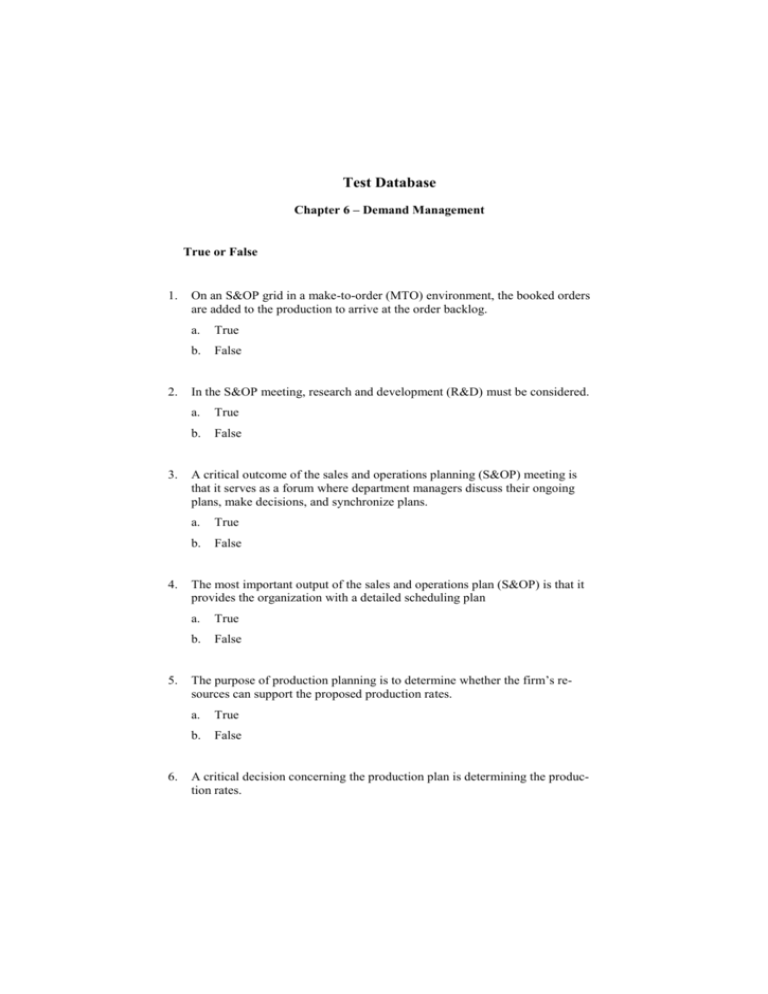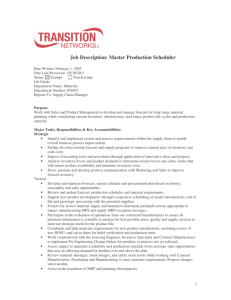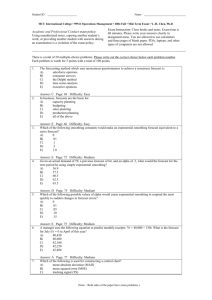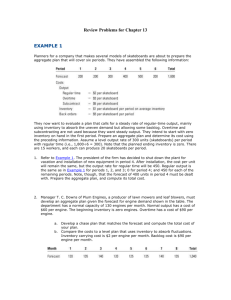Test Database Chapter 6 – Demand Management True or False On
advertisement

Test Database Chapter 6 – Demand Management True or False 1. 2. 3. 4. 5. 6. On an S&OP grid in a make-to-order (MTO) environment, the booked orders are added to the production to arrive at the order backlog. a. True b. False In the S&OP meeting, research and development (R&D) must be considered. a. True b. False A critical outcome of the sales and operations planning (S&OP) meeting is that it serves as a forum where department managers discuss their ongoing plans, make decisions, and synchronize plans. a. True b. False The most important output of the sales and operations plan (S&OP) is that it provides the organization with a detailed scheduling plan a. True b. False The purpose of production planning is to determine whether the firm’s resources can support the proposed production rates. a. True b. False A critical decision concerning the production plan is determining the production rates. 2 7. 8. 9. a. True b. False The pyramid forecasting technique is a process focused on creating the forecast for end-products (SKUs). a. True b. False Demand management portfolio strategies are used to structure supply chains based on demand and supply economics. a. True b. False According to the product life cycle concept investment in products is highest at the growth stage. a. True b. False 10. Similar to products, services also possesses a life cycle. a. True b. False Multiple Choice 11. Which of the five plans resulting from the S&OP process is concerned with aggregate resource profiles and bills of resources? a. Marketing/sales planning b. Production planning c. Resource planning d. Distribution planning 12. An effective tool for the product planning functions of the sales and operations planning (S&OP) is 3 a. Niche marketing analysis b. Customer buying analysis c. Sales/profit analysis d. Product life cycle analysis 13. Which of the following statements best describes how the production plan is related to the resource plan? a. The production plan is constrained by the resource plan. b. The production plan operates independently of the resource plan. c. The resource plan drives the production plan. d. The resource plan cannot succeed without a level production plan. 14. In which of the following product life cycle stages would planners most likely use judgmental forecasts? a. Introductory stage. b. Growth stage. c. Maturity stage. d. Decline stage. 15. Which of the following formulas correctly describes how to calculate the production rate? a. (Ending inventory – beginning inventory) + forecast / number of periods. b. (Beginning inventory – ending inventory) + forecast / number of periods. c. (Forecast + ending inventory) – beginning inventory / number of periods. d. (Ending inventory + beginning inventory) – forecast / number of periods. 16. Which of the following statements is best concerning sales and operations planning (S&OP)? a. It provides a means of updating the material requirements plan b. It includes only the marketing and production plans c. It is usually updated on a monthly basis d. It has no effect on inventory levels 3 4 17. The focus of the sales and operations planning (S&OP) process is to balance customer demand and: a. Inventory investment b. Capacity utilization c. Supply plans d. Master scheduling 18. Which of these planning areas is concerned with long-term planning of manufacturing activity? a. Sales and operations planning b. Master production scheduling c. MRP d. Production activity control 19. When it comes to inventory planning, sales and operations planning is primarily focused on: a. Product mixes b. Product volumes c. Stockkeeping units d. Customer orders 20. Which one of these demand strategies is concerned with the delivery of services? a. b. c. d. Growth Positioning Investment Portfolio 21. Which one of these levels is at the top of the product hierarchy? a. b. c. d. Product class Product family Product line Product type 5 22. Which one of these is at the very heart of successful demand planning? a. b. c. d. Customer segmentation Pricing and discounting Products and services Brand strategy 23. In which one of these product subcategories is found consumer-type goods such as paint, nails, small tools, and fuels? a. b. c. d. Raw materials Capital goods MRO goods Convenience goods 24. In which product life cycle stage would the supply channel be the most complex? a. b. c. d. Introduction Growth Mature Decline 25. In which product life cycle stage is product investment the lowest? a. b. c. d. Introduction Growth Mature Decline 26. Which of the following attributes differentiates services from products? a. They are delivered and consumed simultaneously b. They can be inventoried for future use c. They are often delivered in based on a standardized format d. Their value to the customer is always tangible 27. The use of social media and Internet marketing would be classified as which of the following? a. Mass marketing. 5 6 b. c. d. Niche marketing. Customer segment marketing. Portfolio marketing 28. A sales strategy where direct salespeople call on large account customers to sell complex and customized products is termed a. b. c. d. Direct sales Leveraged sales Team-based sales Contractual sales 29. The goal of pyramid forecasting is to a. b. c. d. Roll-up demand history from finished goods sales Enable the demand team to calculate the aggregate forecast Enable the demand team to separate aggregate forecasts by product family Connect the aggregate forecast with the firm’s finished goods requirements 30. Which one of these sub-plans of the supply plan is concerned with shipment, warehousing and transportation capacities? a. b. c. d. Production plan Resource requirements plan Inventory plan Distribution plan 7 Answer Key 1. F 2. T 3. T 4. F 5. F 6. T 7. F 8. F 9. F 10. T 11. c 12. d 13. a 14. a 15. a 16. c 17. c 18. a 19. b 20. d 21. b 22. c 23. c 24. c 25. d 26. a 27. b 28. b 29. d 30. d 7











